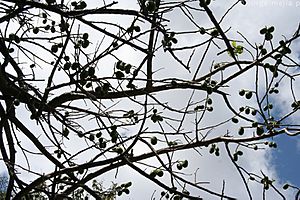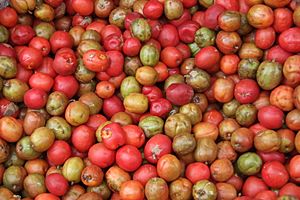Jocote facts for kids
Quick facts for kids Jocote |
|
|---|---|
 |
|
| Conservation status | |
| Scientific classification | |
| Genus: |
Spondias
|
| Species: |
purpurea
|
The Spondias purpurea is a type of flowering plant in the cashew family. It is also known as jocote, red mombin, or purple mombin. The name "jocote" comes from an old word meaning "sour fruit."
This plant grows naturally in warm, tropical parts of the Americas. You can find it from Mexico all the way to Brazil. It is also very common on many Caribbean islands. People love to eat the fruit in Central American countries like El Salvador, Nicaragua, Honduras, and Costa Rica.
Contents
History of the Jocote
Jocote trees have been important to people in Mexico and Central America for thousands of years. People used them for food and also for traditional medicines. The trees were also planted to create living fences and to help stop soil from washing away. A sticky sap from the tree was even used as a type of glue!
Jocote trees originally grew from southern Mexico down to northern Peru and parts of Brazil. They are most common in Mexico and Central America. Spanish explorers later brought jocote fruit to the Philippines, where it is also very popular today.
Since 2011, jocote has been grown more widely in Chiapas, Mexico. This helps create jobs for local farmers. It is also a good tree to plant in areas where soil erosion is a problem. There are many different kinds of jocote fruit, with over 50 types recorded in Nicaragua alone! They can look quite different in color and shape. Jocotes are related to mangoes and cashew trees.
Sadly, some of the wild jocote trees have become less common. This is because their natural forest homes have shrunk. But by growing these trees in gardens and as fences, people have helped save many different types of jocote plants.
What Does a Jocote Look Like?
Jocote fruit grows on trees that lose their leaves in warm, tropical places. The tiny red flowers appear first, even before the leaves grow. The fruit then develops on thick, bumpy branches, either in bunches or by themselves.
The fruits are usually about 2.5 to 5 centimeters (1 to 2 inches) wide. They are a bit long and can sometimes have an odd shape. Young jocote fruits are green or yellowish-green. As they get ripe, they turn purple or red. Some types ripen to a yellow color.
The skin of the fruit is thin and looks a bit waxy. You can eat the skin! Inside, the fruit has a yellow, sweet pulp when it's ripe. In the middle, there is a large, hard pit or stone that you cannot eat. The taste of a jocote fruit is often compared to a plum. It is sweet but has a slightly tart taste afterward. You can usually find jocote fruit in the fall and winter months.

Jocote fruits are good for you! They have lots of Vitamin C and carbohydrates. They also provide calcium, phosphorus, iron, and a little bit of fiber. Plus, they contain important vitamins like carotene and B-complex vitamins. Jocotes are also high in antioxidants, which help keep your body healthy.
How to Enjoy Jocote Fruit
Most people like to eat jocote fruit raw when it is fully ripe. Ripe fruits will feel soft when you touch them and are very sweet. You eat them just like a plum or mango, enjoying the soft pulp and throwing away the pit.
You can also use the pulp to make drinks. Just mash it up and mix it with water and a little sugar. Sometimes, whole fruits are boiled with sugar and other fruits to make a sweet syrup or "honey." This syrup is delicious with ice cream or as a dessert on its own. You can also cook the whole fruits to make preserves, straining out the seeds from the liquid. Boiling and drying jocote fruits can keep them fresh for several months.
Unripe fruits can also be eaten, but they are much more tart and a bit bitter. People often turn them into a sour sauce. They can also be pickled in vinegar or lime juice and eaten with chili peppers and salt. In many Central American countries, you can buy ripe jocote fruit from street vendors in plastic bags. Sometimes, they come with hot pepper sauce or a special ground pumpkin seed topping.
In Costa Rica, it is common to eat the ripe fruit with salt. In El Salvador, a popular jocote dish is a syrup made from panela. Panela is a type of molasses made from sugar cane juice. In Panama and coastal Ecuador, the jocote tree is often used as a living fence around farms.
Images for kids
See also
 In Spanish: Jocote para niños
In Spanish: Jocote para niños




